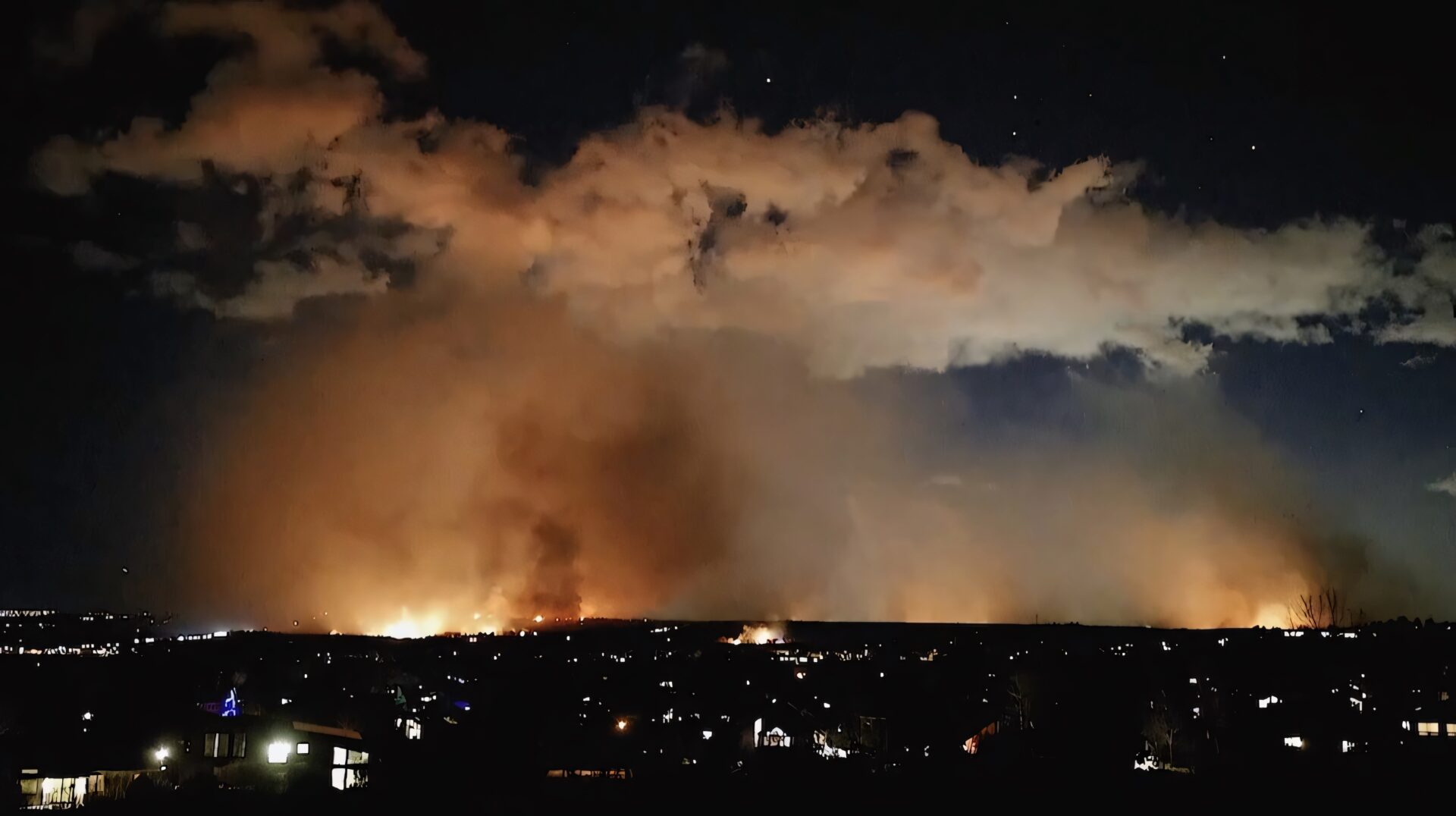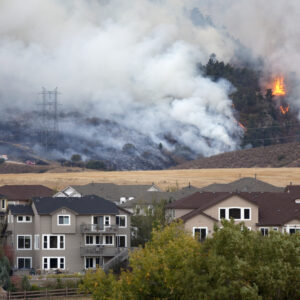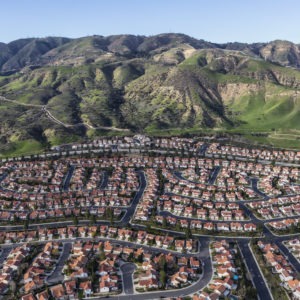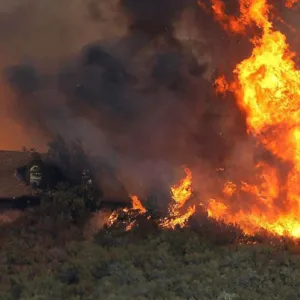Today marks the release of the Wildland Fire Mitigation and Management Commission’s final report of recommendations for the future of U.S. wildfire policy. Established by Congress in the Bipartisan Infrastructure Law, the Commission comprises members from federal agencies, the scientific community, the private sector, and Tribal governments who have come to consensus on nearly 150 policy recommendations for federal action, many of which suggest new directions in how we should address a wildfire crisis that is threatening more communities than ever. Recommendations will be submitted to Congress for consideration.
Headwaters Economics’ senior wildfire researcher, Dr. Kimiko Barrett, was one of the 50 members appointed to the Commission and helped lead recommendations regarding community risk reduction.
The Commission’s report, “On Fire: The Report of the Wildland Fire Mitigation and Management Commission,” concludes that to better address increasing wildfire risks, equal emphasis must be placed on both the unbuilt and built environment. In other words, actions such as managing wildland fuels and building homes and other buildings to wildfire resistance standards are necessary for reducing risks. This is an important and overdue modification of longstanding wildfire approaches that have almost exclusively emphasized managing fire in wildlands. The Commission’s detailed recommendations bring new attention to underutilized yet very effective solutions for communities that are seeking to protect homes and livelihoods.
Consensus of the wildfire community
Several details make this report unique. Perhaps most importantly is that it brought together the entire spectrum of the wildfire community, including those who could offer insights as to how policies can guide risk-reduction efforts before, during, and after wildfires.
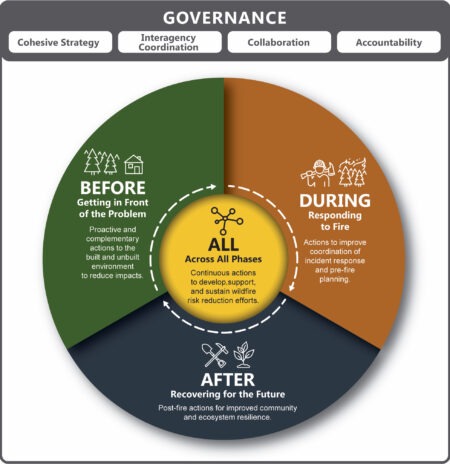
Federal and nonfederal experts, state, local, and Tribal governments, and the private sector all had representation, and all of the recommendations in the report are a result of unanimous consensus. To make it into the report, each recommendation had to achieve agreement among Commission members. This means that every recommendation is backed by a diverse group of Commission members who believe in its effectiveness.
The report stands out for its comprehensive assessment of the federal wildfire management system. In addition to policy recommendations, it addresses how the recommendations related to workforce capacity, technology, appropriations, public health, and community safety can be operationalized.
Acknowledging the barriers to effective wildfire management
The Commission’s report calls for a transformational shift in our approach to wildfires. Wildfires provide important ecological benefits to most ecosystems, and in many places there is even a need for more beneficial fire on the landscape. At the same time, wildfires are posing an increasing risk to structures and communities.
This report acknowledges that wildfires are inevitable and increasing, and even necessary in fire-adapted ecosystems. The Commission adopts the view that a new proactive, multiscale, and interagency approach is needed in how we plan for, respond to, and recover from wildfire.
It is through this lens that the Commission found that the current programs and approaches designed to reduce wildfire risk to communities are insufficient. When it comes to the actions that a town, county, or even individual neighborhood can take to mitigate wildfire risk, federal resources are insufficient and ineffective in meeting the scale and pace of the problem. Even with available funding, many communities lack the expertise, resources, and capacity to apply for and manage grants or to implement and maintain mitigation actions needed at the local level.
Further exacerbating the challenge, limited funds spread across a confusing constellation of programs are available to communities to reduce wildfire risk to structures, private properties, and infrastructure. The burden falls to local jurisdictions to navigate and piece together the limited programs that do exist in order to meet their mitigation needs.
Wildfire responses must address the built environment, as well as wildlands
Traditional policy response and investment has concentrated on managing the unbuilt environment (“wildlands”). The Commission found that the focus on wildlands fails to account for the role of structures, development, and infrastructure in mitigating community wildfire risk.
The first recommendation in the report calls for federal agencies to invest in the built environment by creating ignition-resistant communities. This recommendation is the first of its kind to explicitly call out the need for federal-level investment in proactive wildfire risk reduction to the built environment via the establishment of an interagency coordinating body with expertise in wildfire, planning, housing, and infrastructure.
The first recommendation reads:
“Congress should establish a Community Wildfire Risk Reduction Program via an interagency coordinating partnership including the Forest Service (USFS), the Federal Emergency Management Agency (FEMA), the United States Fire Administration (USFA), the Bureau of Land Management (BLM), and the National Institute of Standards and Technology (NIST) as principal agencies, to proactively address wildfire risk reduction actions and increase ignition resistance of the built environment.”
The recommended approach would provide multifaceted support for communities in reducing their wildfire risk through technical assistance, direct competitive and noncompetitive grants, private-public partnerships, financial incentives for mitigation measures, training and knowledge generation, building code guidance, subsidies for disadvantaged households, and capacity building, among other priorities for community adaptation to wildfire.
The proposed Community Wildfire Risk Reduction Program calls for establishing an interagency coordinating body with expertise in urban planning, disaster resilience, wildfire risk, and research and science to holistically address the needs, gaps, and opportunities to improve long-term resilience of the built environment. This is similar to national hazard responses of the past. In 1977, the United States created the National Earthquake Hazard Reduction Program that established cross-agency collaboration to help local and state governments implement building codes, provide funding, and support education programs that would reduce the potential impacts of earthquakes. Hundreds of communities have since benefited from the program.
A wide-ranging and sustained response is needed
Balancing more resources to prepare the built environment for inevitable wildfires and establishing an interagency coordinating body were not the only subjects explored by the Commission. Other recommendations discuss improvements in post-fire recovery efforts, employing new technologies and AI for detection modeling, workforce development, broad application of prescribed burning, Indigenous cultural burning, and managed fire for landscape benefits, among other recommendations. In fact, the report includes nearly 150 recommendations grouped into various themes that will be useful for the future of federal wildfire policy.
Beyond recommendations specific to the built environment, other key findings identified by the Commission:
- Breaking the current cycle of increasingly severe wildfire risk, damage, and loss will require investments in proactive planning, mitigation, risk reduction, recovery, and the workforce needed to accomplish these tasks. In achieving this, governance systems and structures must be more inclusive of nonfederal entities such as state and Tribal governments, organizations, and communities.
- Federal agencies should not – and in fact, cannot – effectively address a challenge of this magnitude alone. The whole of society must be involved. Getting communities engaged will require restructuring federal programs to be more equitable, accessible, and easier to navigate.
- Beneficial fire – including prescribed burning, cultural burning, and wildfire managed for resource objectives – is necessary to restore fire-adapted ecosystems and reduce the risk of high-severity wildfires that pose a significant threat to communities.
We cannot wait when it comes to reducing wildfire risks
A new emphasis on proactive investment in reducing wildfire risk, empowering communities, and comprehensively addressing the entirety of the wildfire spectrum is an approach that cannot wait. While the recommendations of the Wildland Fire Mitigation and Management Commission provide policy guidance for Congress, real change will only come when all of society becomes part of the solution.
We have the tools to reshape wildfire management in ways that will make our landscapes more resilient, our communities thrive, and our future better adapted to living with fire.
